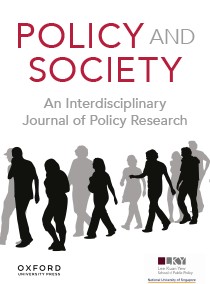设计排斥:印度城市住房补贴计划的案例研究
IF 6.1
1区 社会学
Q1 POLITICAL SCIENCE
引用次数: 0
摘要
Pradhan Mantri Awas Yojana(城市)-全民住房任务(PMAY-U)是印度政府的旗舰任务,旨在通过五种不同的计划解决城市地区对经济适用房的需求。其中一个计划是房屋补贴计划,即信贷挂钩补贴计划(CLSS),该计划对PMAY-U的成功作出了重大贡献。然而,CLSS计划的设计有利于被认为有信誉、有稳定和安全收入流的家庭。本文考察了CLSS计划的政策设计和实践之间的差距,以探讨偏见如何嵌入政策,导致经济弱势家庭被排除在外。施耐德和英格拉姆的目标人群社会建构(Social Construction of Target Population, SCTP)框架用于识别CLSS政策链中涉及的目标群体。我们采访了这些目标群体和政策制定者,以了解他们对经济适用房概念的理解。使用关系透镜,比较这些解释,以了解如何在CLSS政策文件中表示经济适用房的含义。该分析提出了两个关键见解。首先,目标群体的权力和利益预测了他们在政策设计和决策中的代表性。其次,私有化的补贴方案实施设计嵌入了消极的选择主义,在CLSS设计中产生了排他性倾向。最后,鉴于全球范围内福利国家的缩减,这项研究提出了一个关键问题:“谁受益,谁输家?”,同时挑战经济适用房政策目标的规范性方面。本文章由计算机程序翻译,如有差异,请以英文原文为准。
Exclusion by design: a case study of an Indian urban housing subsidy scheme
The Pradhan Mantri Awas Yojana (Urban)—Housing for All mission (PMAY-U), a flagship mission of the Government of India, aims to address the need for affordable housing in urban areas through five different schemes. One of these schemes is a housing subsidy scheme, the Credit Linked Subsidy Scheme (CLSS), which has significantly contributed to the success of PMAY-U. However, the design of the CLSS scheme favors households considered creditworthy, with stable and secure income streams. This article examines the gap between the policy design and practice of the CLSS scheme to explore how biases get embedded into the policy, resulting in the exclusion of economically vulnerable households. Schneider and Ingram’s Social Construction of Target Population (SCTP) framework is used to identify the target groups involved in the CLSS policy chain. These target groups and policymakers were interviewed to understand their interpretations of the concept of affordable housing. Using a relational lens, these interpretations are compared to know how the meanings of affordable housing get represented within CLSS policy documents. The analysis presents two key insights. First, the power and interests of the target groups predict their representation in policy design and policymaking. Second, privatized implementation design of the subsidy scheme embeds negative selectivism creating exclusionary tendencies in the CLSS design. Lastly, given the shrinking of the welfare state across the globe, this study raises the critical question of “who benefits and who loses?” while challenging the normative aspects of the policy goal of affordable housing.
求助全文
通过发布文献求助,成功后即可免费获取论文全文。
去求助
来源期刊

Policy and Society
Multiple-
CiteScore
18.00
自引率
6.50%
发文量
43
审稿时长
30 weeks
期刊介绍:
Policy and Society is a prominent international open-access journal publishing peer-reviewed research on critical issues in policy theory and practice across local, national, and international levels. The journal seeks to comprehend the origin, functioning, and implications of policies within broader political, social, and economic contexts. It publishes themed issues regularly and, starting in 2023, will also feature non-themed individual submissions.
 求助内容:
求助内容: 应助结果提醒方式:
应助结果提醒方式:


